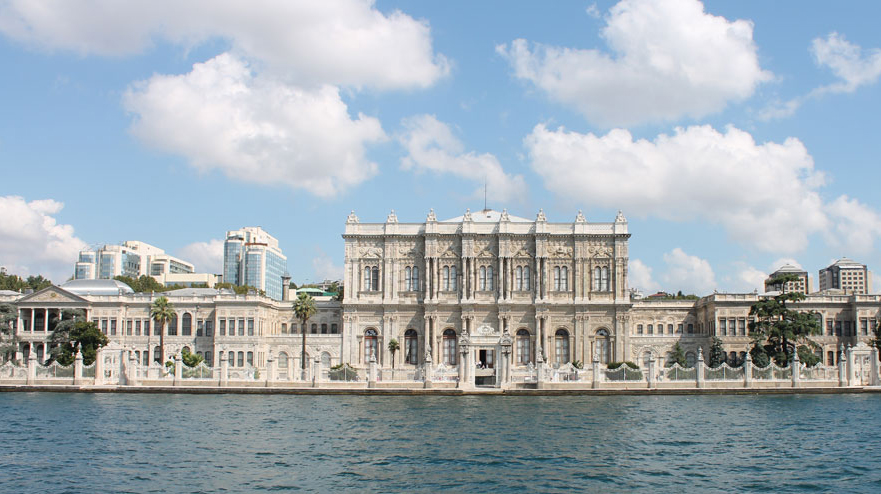An Armenian Island on the Bosphorus

By Raffi Bedrosyan
What makes Istanbul beautiful is the Bosphorus ,dividing the city between Europe and Asia. And what makes the Bosphorus beautiful is a series of architecturally magnificent palaces, mansions, and mosques.
Most of these architectural masterpieces on both sides of the Bosphorus are created by one Armenian family of architects: the Balyans. This article will explain the little-known history of the only island in the Bosphorus and its connection to the Armenians, specifically to the Balyans.
View of Constantinople and the Bosphorus, by
Ivan Aivazovsky – Oil of canvas, 1856 (Photo: Sothebys)
Some three generations of Balyans served the Ottoman Sultans in the 18th and 19th centuries, building a multitude of palaces, mosques, barracks, schools, and clock towers for the Ottomans. The Balyans also built churches, schools, and mansions for the Armenian communities all over the Empire, but mostly in Istanbul, and specifically along the Bosphorus.
Among the most notable Bosphorus works by the Balyans are the Palace, Mosque, and Clock Tower of Dolmabahce; Beylerbeyi Palace; Ciragan Palace (now a luxury hotel); Kuleli Military School (used as an orphanage by the British Army after WWI to gather thousands of Armenian orphans rescued from Turkish and Kurdish homes); Ortakoy Mosque; Kucuksu Palace; and several other mansions. The Turkish Tourism Ministry and official guides refrained from identifying the architects of these buildings as the Armenian Balyans until the 2000s and instead mentioned an Italian architect called “Baliani.”
While the Ottoman Sultans ordered the Balyans to build one palace after another, they started to pile up enormous amounts of debt and had to declare bankruptcy in 1876. The Chief Architect of the Empire, Sarkis Balyan, was owed large sums of money as well, and Sultan Abdulhamid decided to give Balyan the only island in the Bosphorus as compensation against his debt. The island was just a formation of rocks across from the village of Kurucesme, right in the middle of the Bosphorus.
Sarkis Balyan decided to build a summerhouse on these rocks to enjoy with the love of his life, his wife Makruhi Dadyan, the daughter of another famed Armenian family in the service of the Ottoman Empire as suppliers of gunpowder and armaments. Unfortunately, Makruhi died young soon after, because of tuberculosis ,and Sarkis started living in seclusion on the island.
The island became known as Sarkis Bey Island, a meeting point for Sarkis Balyan’s intellectual and artistic friends. One of his guests was famed Armenian-Russian painter Ivan Hovhannes Aivazovski, who always stayed on this island whenever he visited Istanbul. Some of his famous seascape paintings were created there.
Sarkis Balyan passed away in 1889, and, unfortunately, the island was not maintained by his heirs. The government took over the island and started using it as a coal depot for the steamships crossing the Bosphorus. In 1940, the heirs of Balyan were successful in having the island returned to their ownership, but they ended up selling the island in 1957 to Galatasaray Sports Club, one of the most prominent sporting institutions in Turkey. The island was renamed Galatasaray Island and expanded with swimming pools and sports facilities. In 2006, it was leased to a private entity for further expansion with several restaurants, as a high society entertainment center. In 2017, much of the expanded facility was demolished by the pro-Islamic government; at present, there are proposals to build a mosque on the original Sarkis Bey Island.
The Bosphorus is connected to Armenians in many other ways. Robert College, the oldest American college outside the United States, was founded in 1863 on the European shores of Bosphorus by Christopher Robert, a wealthy philanthropist, along with missionary Cyrus Hamlin.
Hamlin had learned Armenian to communicate with the first students of the boarding school: Armenian boys. The school expanded rapidly and became a leading educational institution in Istanbul, eventually adding a university with many faculties. Until WWI, most of the students were minorities—Armenians, Greeks, Bulgarians, and Jews. Unfortunately, the Armenian Genocide claimed several Armenian graduates of Robert College, along with the rest of Armenian intellectuals. Prominent Armenian journalist Teotig (Teodoros Lapchinjian), who compiled a list of the Armenian intellectual victims in his 1919 book Memorial to April 24, mentions at least 10 Robert College graduates murdered by execution or massacre.
I will conclude with a personal anecdote. I was also a high school student at Robert College. Our Phys Ed teacher was Abbas Sakarya, the first Turkish wrestling champion who had won international gold medals, the first accredited gymnastics coach, the first founder of a swimming academy, and an all-around sports legend in Turkey. He was a very strict, severe man who never cracked a smile.
Robert College held annual Bosphorus Crossing swim races from the Asian to the European side. The width of the Bosphorus Strait is about a mile, but with the treacherous currents one has to swim double or triple that distance during the crossing. Along with dozens of other university and high school students, I also participated in the race and ended coming in second among the high school students. Mr. Sakarya congratulated me and, along with a rare smile, whispered into my ear: “Abris,” in Armenian (“bravo”).
At the time, I thought he might have used that word as a complement because he knew I was Armenian. But, years later, near his death at age 97, I found out that this Turkish legendary sportsman and teacher was in fact a hidden Armenian from Bursa—and an orphan of the Genocide.
There are many secret and untold stories about Armenians in Turkey. Turks may not know or may not want to know them, but they must be told.





